1 hour 24 minutes of Dali time, rated 2.5/10 from 415 on the IMDB
In the effort to ride on the ticket sales of ‘Star Wars’ this quickie was rolled out, one of several Italian efforts of this kind. It is hard to get a rating as low as 2.5 on the IMDB.
It is, oh hum, another yarn about the end of the world. A mysterious spaceship appears from the void and penetrates all the many space defences Earth has, satellites, space stations, rhetoric, and an armanda are brushed aside. There is no reply to communication and atomic missiles bounce off.
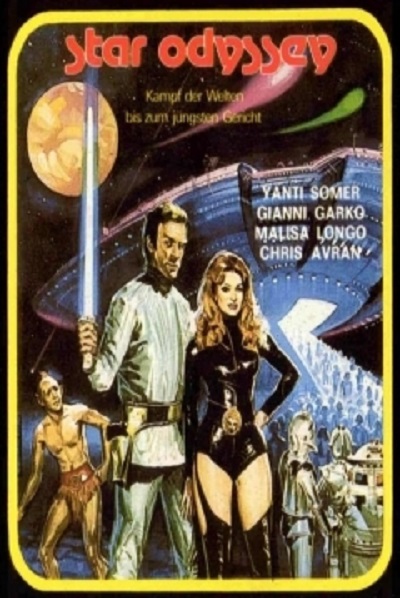
There is only one thing to do in this crisis! Yes, project the Bat Signal into the night sky.
But wait, Batman took early retirement and is unavailable. Forget about, Robin. He was only ever there to hold the cape.
Instead High Command calls in Big Brain; Italian screen writers have an endless supply of bad tempered professors on call and Big Brain gets this part. He carries on like he is God’s gift to the world, while much of the world is destroyed. He rants on.
Later by some fancy screen writing the villain is defeated. The end.
At the end we learn the villain is a mega Meriton developer who bought the Earth at an auction to market its population as McKinsey KPI slaves. That might have been a better start.
The villain had some makeup! The fraternity brothers could not decide whether it was a road map of New Jersey projected onto his face or he was wearing the netting from last year’s Christmas ham, but he looked weird. In addition, his spaceship was overdue for service because it evidently has killer drafts, considering the triple high collar he wore on the back of his neck.
To subdue the Earth’s primitive inhabitants this bogey man dispatches an endless army of wig wearing androids, who when cut in half look like robots, but the characters insist on calling them androids. Droids or Bots, they all look alike to me.
The Earthlings fight them off with camera flashes. Honest, that is what it looked like. Luke also lent them a light sabre. Yes, indeed.
The decor of Big Brain’s house is all very stylish, I am told, but he never dirties his hands with any science, though some of the Z-team he assembles peer down lens and point at steaming vials.
There are also two or three robots brought onto the team who move like molasses and only bicker among themselves. These two would be an asset in any fight to save the world, not! Ditto the rest.
Though most of the film concerns assembling this team of Z-grade treacle, they prove ineffective against the Bogey Man and his wig-wearing automatons. As a last resort Big Brain wills the Bogey Man away. Wow!
Frontal lobes are creased in ominous and continuing silence. The Bogey Man relents. So that is what it takes to save the world. Wrinkle the frontal lobes and hang on.
There is also a lot of staring as coloured lights play on the irises of the one staring. If it was hypnotism it did not make the time pass any quicker, though we all hoped it would.
In contrast to some of the other Italian stallions in this stable of ‘Star Wars’ copies, the players in this one seem to be in on the joke and none try too hard to make it stick.
The title roughly means ‘Seven golden (hu)men(s) in space’ making this a variant of the Seven Samurai. Note the seven includes at least two women in this case. None of the characters is developed and none of their talents contribute to the defeat of Bogey Man. Figure that out. Why it appears in English as ‘Star Odyssey’ is anyone’s guess. It has also been marketed as ‘Prisoners of a Lost Universe’ but that may refer to the money put by the investors. It has been released under several other titles too trivial to list. But beware.
Category: Film Review
‘Ice Planet’ (2001)
A German production running 1 hour and 23 minutes, which rates 4.0 from 10 on the IMDB from 924 votes. Oh. My vote would be zero (0). The video quality is HD but the sound is not. It is replete with CGI and when they appear it is loud, while the dialogue is quiet. Up and down went the volume.
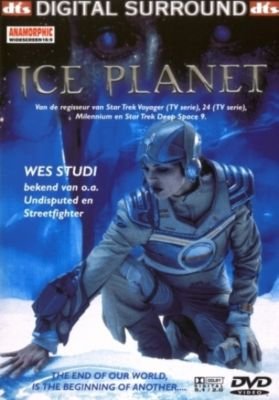
The plot? Good question, one I still have though I watched it. Some Earthlings on a space station get attacked and take off, ending up on the Ice Planet. It is a mixed bag of space cadets. travellers, research scientists, and odd balls. (Yes, really fresh-faced space cadets.) Now they have to work together to survive.
Sound familiar? Try Star Trek: Voyager, for one.
The players are the usual suspects. The martinet commander, the slinky woman, the bewildered astronomer, the square jawed cadet, the androgynous waif, and many disposable red shirts. The red shirts get toasted and roasted by a variety of mean CGIs. Boom, crash, wham! Perhaps forty minutes of the picture in all is a CGI mosh pit nonsense.
The visuals of the ice planet are neat but contribute nothing to the plot. They might just as well have landed in New Jersey for all the relevance it has.
A meeting with Ice natives made-up like Inuits is promising but dissipates into nothing. What I liked was the challenge of communicating without a language on the home turf of the Inuits.
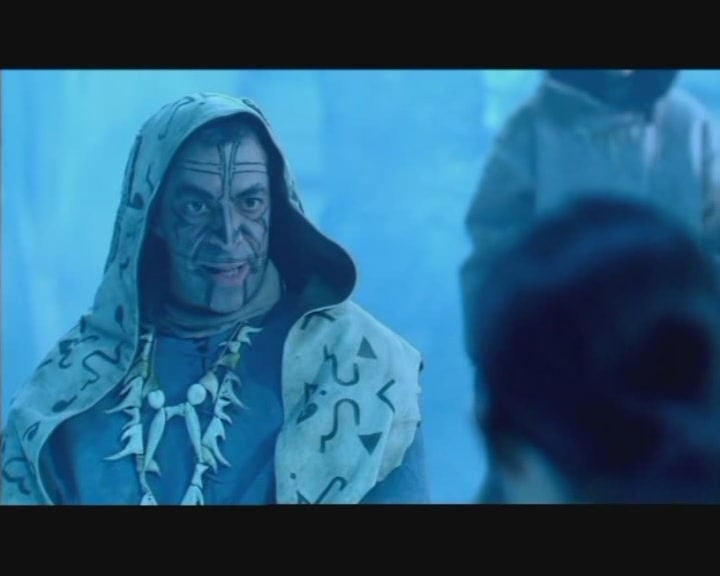 Moreover, with their local knowledge they seemed like good allies, but no…..
Moreover, with their local knowledge they seemed like good allies, but no…..
Enigmatic or unintelligible, cryptic or vague, mysterious or incomprehensible, puzzling or impenetrable, full of ideas or indigestible, stimulating or half-baked? Those who gave it a 4.0 or higher on IMDb went for the former in each of the preceding pairs. Me, went for the latter in each case.
The IMDb has a plot summery that may have come from the press kit, because no one relying only on viewing the film would find it even that coherent. There seems to have been plenty of budget for CGIs but not for a continuity editor, and that adds to the confusion. The sound technician was AWOL.
Yet the director was Winrich Kolbe who has many credits from the Star Trek franchise. Many. Now that is a mystery. How did he come to make this…, hum, pastiche seems too elegant a term.
This was a movie-length pilot for a television series, and so we have something for which to be grateful. It was not continued. Reviewed elsewhere on this blog is ’Destination Space’ (1959) was likewise a pilot that failed but a far better exercise with some intellectual content and character development in a mere 41 minutes.
Much of it was filmed in Canada, and a web whisper is that Michael Ironside was in line for the captain’s chair if the series eventuated. Seems best this way.
‘Anno zero – Guerra nello spazio’ (1977) ‘War of the Planets’
2.9/10 from 617 brave souls but the zero (0) in the title seems to have application. It runs 1 hour and 29 minutes Dali time.
The only surprise here is that it is rated as high as 2.9 from 10. One of the many films trying to cash in on the success of ‘Star Wars’ but there is no comparison on any score. It looks like something from Poverty Row in the 1950s. The props look like leftovers from Flash Gordon of that era.
A strange signal disrupts all communication. That much is clear and that it about all that is.

The Italians launch a Ferrari space ship which traces the signal to an undiscovered planet somewhere. They need to clean the lenses on the telescopes more often to spot these things.
On this murky planet they find a giant juke box robot that has enslaved the humanoid locals with a GOP spiel and is now after the Earth! The plucky Italians in cute, colour coded skull caps set out to put things right amid incomprehensible cross-cuts, dialogue that sounds like out-takes from another film, a soundtrack that bears no relation to the action on the screen, until one of the crew takes off the skull cap and goes nuts. Guess that is why they keep them on. Prevents going nuts.
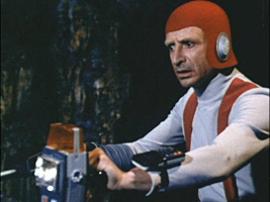
Proof? Did Silvio Berlusconi ever sport a skull cap? No. Is he nuts? Yes.
Most of it is so dark and so poorly photographed, who knows what is going on. The fraternity brothers made many rude remarks about this.
Our heroes, their numbers diminished in the dark, confront the juke box and talk it to death, and thus distracted, they then blow it up. At last!
Most of the cast and crew are Italians using English aliases, for reasons best known to the marketing department.
‘Il pianeta degli uomini spenti” or ‘The Battle of the Worlds’ (1961)
The IMDb info is this: 1 hour and 33 minutes of Dali time, rated at 4.3/10 by 563 ratings.
Long before Star Wars, the Italian cinema offered this title. Directed by Antonio Margheriti, who like others in the cast, used an Anglo pseudonym in the credits. In his case, it was Anthony Dawson. The aim was to sell the film into the American market, and along with the aliases, the director/producer recruited the Invisible Man Claude Rains for that purpose.
The set-up makes as much sense as some of the later Italian Sy Fy films. Z e r o.
Rains is a curmudgeon and at first I liked that but it went on and on and on. He lives in a palace by the seaside somewhere surrounded by bright young things. Easy to see why Rains liked the part for the three or four days he spent on it. Every one stands when he enters a room, and the bow their heads to him. Moreover the set abounds with sunshine, nubile and virile creatures coming and going, and no script to remember, just snarl.
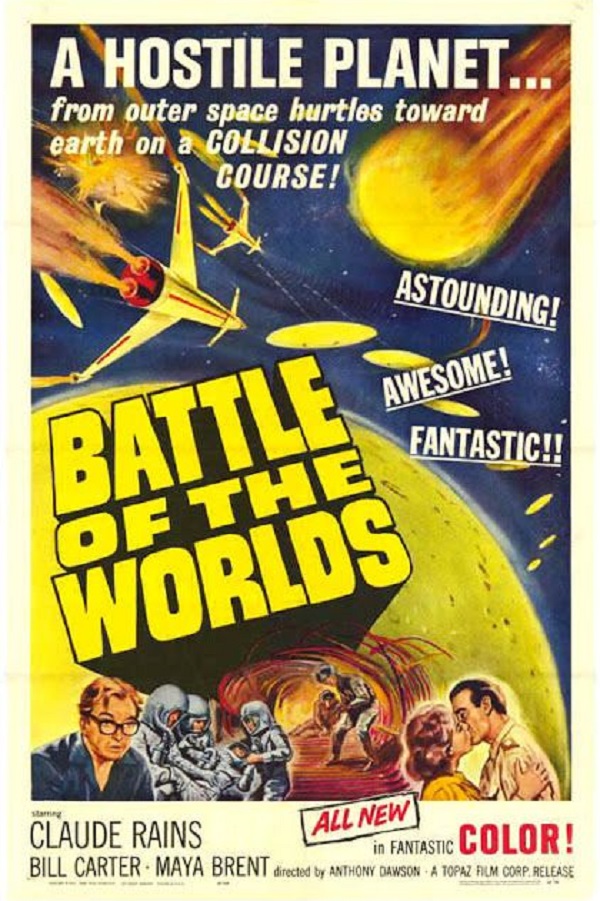
Downstairs in his palace is a scientific establishment that by some unspecific means monitors the heavens. The fraternity brothers accomplish this with beer. How it is done in this seaside palace is less clear. Many bright scientists come and go; sometimes they enter Rains’s inner sanctum where they bow and hand him written reports in ring-binders. Furturistic, not. He looks disdainfully at their efforts, and in one case, while declaiming how useless the report is, an over the shoulder close-up shows he is holding it upside down. Well, it would not make much sense that way, would it. (Though I have tried that a few times with journal manuscripts I have had to review.)
He tells everyone how stupid they are repeatedly. He must be emeritus because he is never going to get another research grant with all the friends he is making.
Thanks to the Stockholm Syndrome, the more he abuses people. the more they think he is a genius. Why did not I try that in my career?
Then the Outsider, Planet X on loan from ‘The Man from Planet X,’ appears in the Solar System. Gulp! All eyes turn to Rains, who tells the eyes how stupid they are. See, he repeats the same line again and again. Easy to remember. He punctuates his castigations with cigar smoke.
High Command mobilises its Ferrari spaceships to blast Planet X. Rains tells them how stupid they are. Planet X will not collide with Earth, and only fools would think it would. However, it will pass so close that it will cause catastrophes of all sorts. This last fact does not bother Rains who is more interested in telling the others how stupid they are, while puffing away on his life-ending cigar.
Stock footage of catastrophes appears on cue. Floods, fires, short-order famines, hysterical people, GOP majorities, and stampeding animals, empty coffee cups and other signs of devastation. Rains tell everyone how stupid they are.
High Command sends the rockets to blast Planet X. Whoa! Flying saucers appear from the surface and blast the rockets. Game and set are lost. The Ferraris were a lot more show than go.
Rains tells everyone how stupid they are.
Planet X goes into orbit around Earth. Laws of physics go out the window. Whooska! Rains admits he had not foreseen this, but quickly recovers to tell everyone how stupid they are.
To prove his point he kneels on the floor and writes a few squiggles with chalk. High Command is so astounded that a man of seventy-two can kneel on the floor and get up that it gives in to his demands.
He claims as his own the discovery of an underling that the flying saucers go wobbly when hit with classical music. Phasers and atomic bombs have no effect, but a piano sonata does the trick. How much better it would have been had it been the Queen of the Night’s aria!
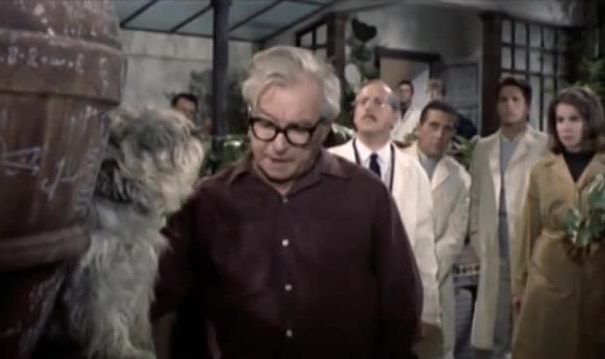 Rains tells everyone how stupid they are.
Rains tells everyone how stupid they are.
At seventy-two he takes rocket to Planet X, but at least this geriatric is not smoking a cigar in-flight. However he does tell everyone how stupid they are.
Sure enough the defending flying saucers go all dishy with the music allowing the Italians to land. Rains penetrates the interior to find THE TRUTH. Meanwhile, the landing party has started a giant doomsday bomb to blast Planet X into the void. (I held out hope this crescendo would be the Queen of the Night’s aria, but no.)
There are no inhabitants of Planet X and the flying saucers were automatons whose code was scrambled by the music. It seems an IOS update killed all the Xers long ago.
While telling everyone else how stupid they are, Rains ignores the calls to return to the rocket and leave before Kaboom. He stands around agape. Maybe he is wondering where his cigars are. No need because KABOOM! Now who is stupid?
The end.
That terse summary makes it sound better than it is. Watch at your own risk as they warn on CSPAN.
‘The Twonky’ (1953)
It runs 1 hour and 24 minutes and it seems like more. Four hundred and twenty-two opinionaters at the IMDb rate it 5.6/10 as of 3 December 2017. A generous lot they are, too.
It comes from the imagination of Arch Oboler, who did much television work, and it seems like an extended skit from a 1950s television variety show.

A hapless college professor, played by that television stalwart, Hans Conreid, buys a television, entering the analogue age with reluctance. This is a man who prefers to listen to Mozart while reading large and dusty tomes. I warmed to him right away. Not so the fraternity brothers who made a play for the remoter that had to be smacked down.
To please Wife, who finds him boring, and who would not, he buys the latest television, a device strange to him. It is delivered and left sitting in his study, it seems, while she is away.
Soon enough its true black-and-white colours show. It is Siri on steroids! A beam from the television knocks the second cup of coffee out of his hand. Not believing his eyes, Hapless tries again. Again a beam from the screen foils the caffeine intake. One cup, yes. Two cups, no.
Thereafter this TV Siri takes over. Its beam whirls records onto an off the turntable. Turns off lights when it thinks he should retire and so on. That beam is handy and it also vacuums the floor, answers the telephone, finishes Prof’s solitaire games, and prepares food. (However it does not mark the pile of student papers he carts around.) Wife being way, he suspects madness.
To get a witness he calls in his buddy, the ageing football coach whose playing days were well before the concussion protocol. Nonetheless, in time coach is also persuaded that the TV Siri is doing all these things. Even when it is not yet plugged in. Yep. No one has plugged it in or anything else and yet it is taking over. Did Marshall McLuhan see this film?
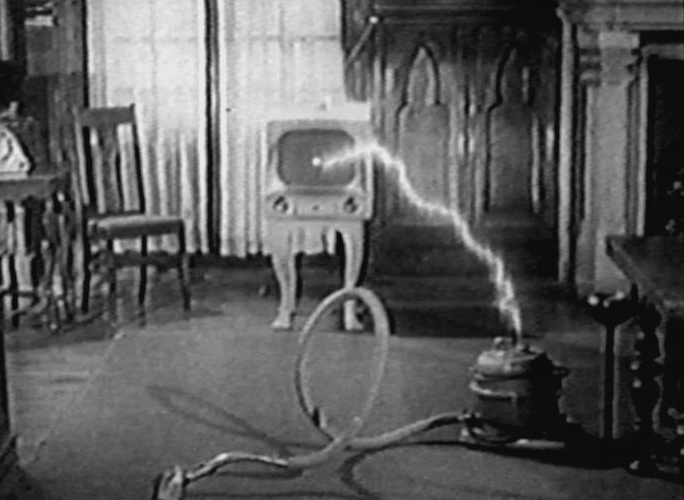 Twonky at work. Siri does not vacuum.
Twonky at work. Siri does not vacuum.
Efforts are made to return the television to the store. Foiled. To reason with it. Foiled. To cover it with a blanket. Foiled. To lock it in cupboard. Foiled. And so on, for forty-five minutes while Coach mumbles and Prof flicks dandruff off his collar, evidently a task Wife usually does.
Coach, after consulting his inner Erich, concludes this is a TV Siri from the future which has traveled back in time. What other explanation could there be?
This is the future that awaits us! A know-it-all Siri which will restrict our free will. It will light one cigarette for Prof but not a second. One a day is OK as with the coffee, but not two.
Prof gets even goofier than television profs usually are and embarrasses himself in front of a class. I kept looking at the clock, noting how slowly Dali time was passing.
Finally, this Siri TV is destroyed, by accident. Whew! Prof is free to drink more coffee and smoke more cigarettes.
Slight though it may seem, it is prescient because we now have our very own Twonky in Siri who can be programmed to ride herd on us.
Slight as it seems Arch Oboler always drives the points home with an axe. This is our future. Control and repression of our freedoms through technology! If so the film offers nothing about how to avoid this micro Nineteen Eight-Four future, but drink that second cup and smoke that second fag while one can.
Oboler’s best Sy Fy is ‘Five’ (1951) though it lacks the leaden humour of this film, it addresses serious subjects, so many that indigestion follows.
The term ‘twonky’ comes from the concussed coach and it means a MacGuffin, something that has no other name.
‘The Invisible Man’ (1933)
From the IMDB: 1 hour 11 minutes, 7.4/10 from 23,534,
Genre schizophrenia here. Is it a horror movie or is it Sy Fy? Arguments over definitions are best because they have no end, and no point.
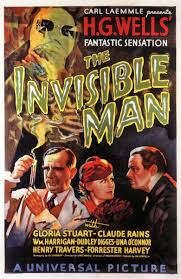
H. G. Wells published the novel ‘The Invisible Man’ (1897) first as a magazine serial and then as a title. His hand makes it Sy Fy, but when Universal filmed it, that studio’s association evoked Horror because Universal had specialised in that genre. Though British in look, it was made in the USA.
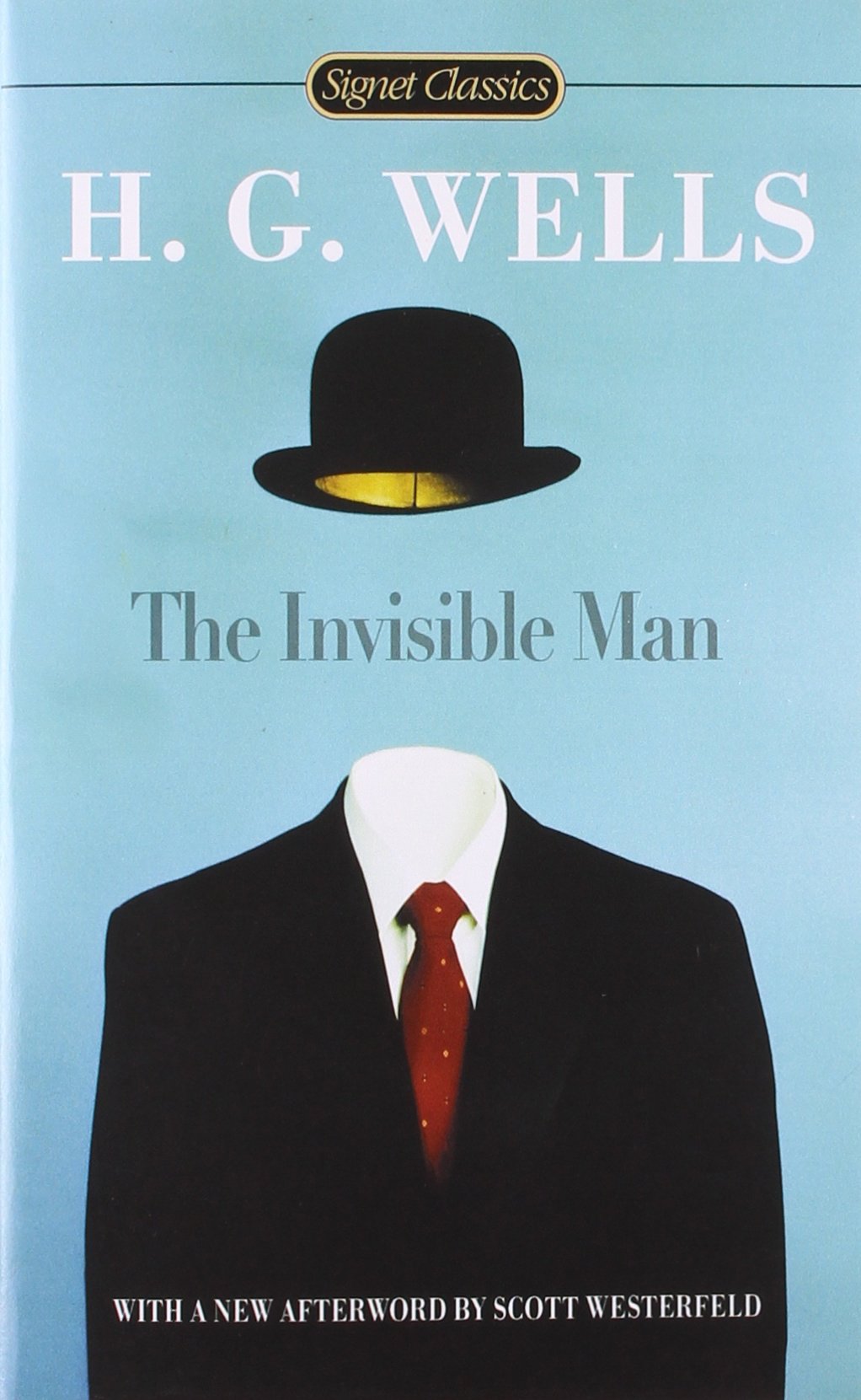
The film differs from the book in several ways. The first and most important is that the Invisible Man is mad from the beginning on film, whereas in the book he becomes more and more unhinged the longer he stays invisible, which may be due to the drugs he is taking for the pain that the invisibility drug causes and the other drugs he is taking trying to become visible again. On top of that he takes strychnine as a pain killer. Killer, indeed. This guy could give the wanna be druggies around Kings Cross lessons in shooting up.
In the film his ambition from the get-go is a Reign of Terror, because he likes having power over others. In the book he comes to this term in his frustration to control the environment so he can concentrate on research to find a way back to visibility. He grows ever more unstable and despicable, but it is a process.
The film gives him a love interest absent from the book. She is played by a luminous Gloria Stuart who later appeared in ‘Titanic’ (1997) and whose last credit was in 2004. There was a sabbatical between 1946 and 1975. There are many familiars in the cast, and some familiar footage that was used again later in other Universal pictures, like the train crash.
While the Invisible Man causes as much mayhem as the fraternity brothers at the end of the semester in the book, in the film the Reign of Terror is not merely a threat, he kills at least two people, including his would-be confederate Dr Kemp. Moreover, he causes a train to crash with countless death and injuries. He is beyond redemption even by the love of good woman.
The book has some discussion of invisibility as a way of being. See! Sartre is relevant, albeit cryptic. (It takes him hundreds of pages to be cryptic. Nausea is certainly relevant to Sartre.) There is no doubt that Wells knew the references to the Ring of Gyges in Plato’s ‘Republic’ and in some way thought he was dramatising something of that philosophical discussion.
The fraternity brothers cut that class, and so for their benefit here is a refresher: Glaucon says a person is only moral because the responsibility imposed by society. Persons free of consequences of their actions would behave selfishly, knavishly, piggishly in the manner of the Tweet in Chief. If an ordinary Josephine came across a ring that could make one invisible, she would get up to no good. Want to know what Plato replied? Read the book! Wells’s novel is an examination of what an invisible person would then do. Though Dr Griffen, the Invisible Man, would hardly consider himself an ordinary chap.
At times I thought of the Invisible Man as an alter ego for Wells himself, and took the study to be autobiographical in a way. This is not a standard interpretation, so do not crib it.
The special effects must have been mind-numbing in 1933. Objects floating in the air, like a telephone. A cigarette smoking itself in mid-air. An unbuttoned shirt dancing by itself. The bicycle riding along sans rider. But most of all the several unveilings when the invisible man removes the bandages that conceal his nothingness. Did Jean-Paul Sartre see this film? Bet he did.
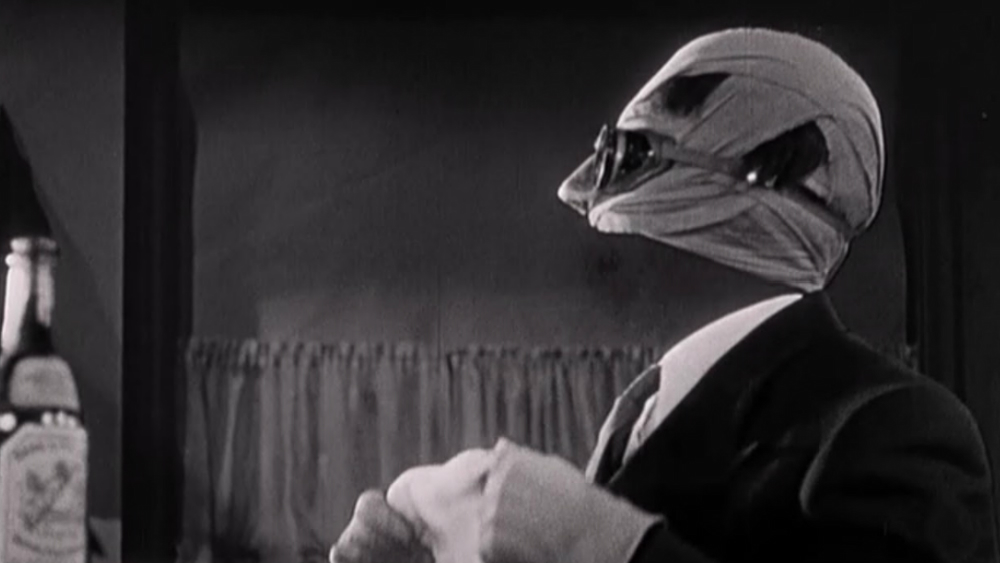 The Invisible Man unveils himself.
The Invisible Man unveils himself.
The denouement is the dealh of the Invisible Man, when the police cordon has finally tracked him down in the fresh snow and dealt him mortal injuries. His shoe prints were easy to track in the snow. Yes, shoe prints. But the shoes were not visible…
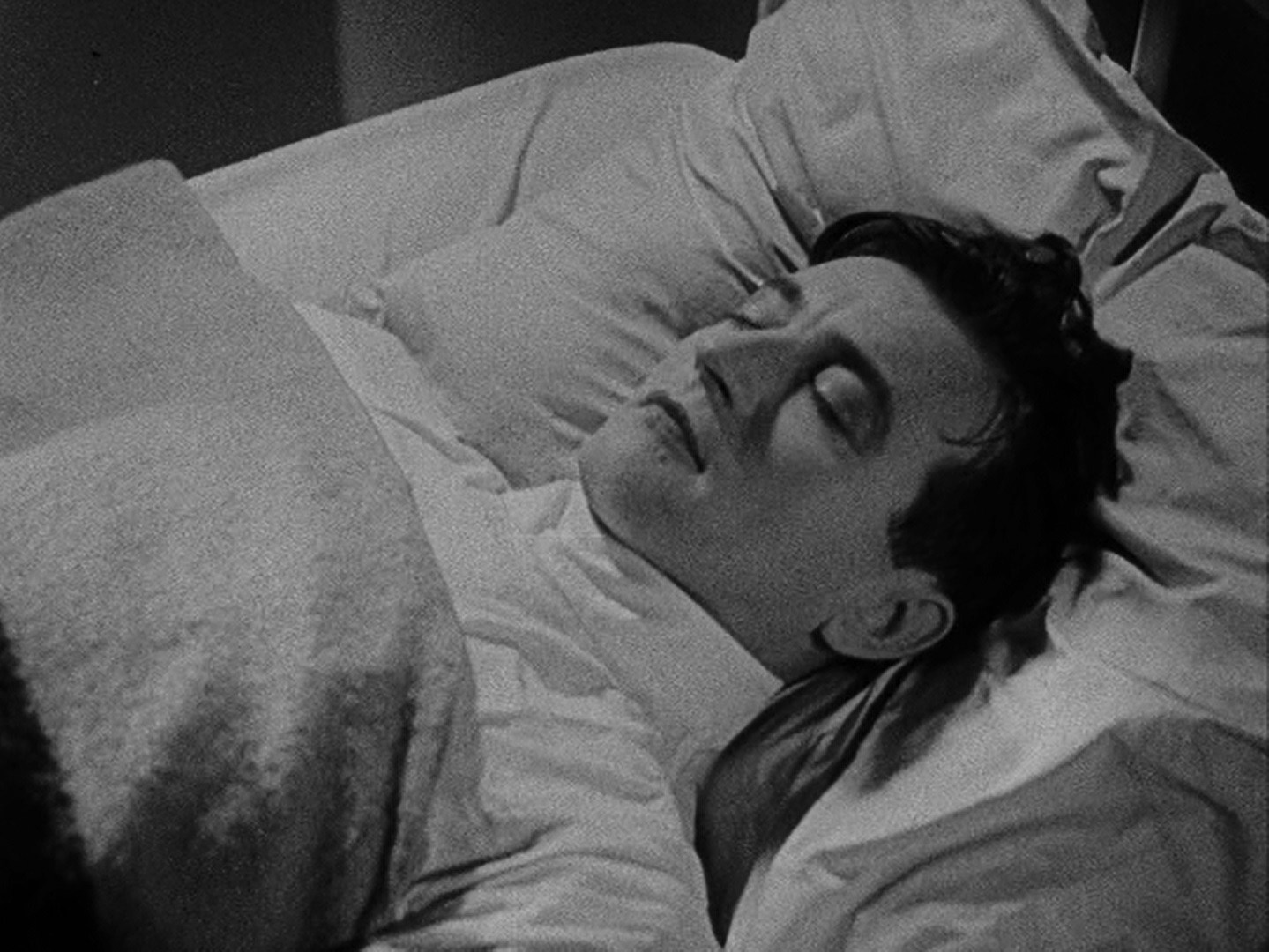
Lying in a hospital bed he gradually dissolves into view as the very young Claude Rains.
By the way, the cinematic invisibility of Claude Rains was achieved by wearing a black velvet body suit with no holes. None. Then putting the bandages on and then the clothes over the top. Altogether an uncomfortable and awkward business. Then he would be filmed against a matte, but the technical matters are best left to technicians. The point is that it was hard work being invisible on film just as invisibility was a curse to Griffin in the story.
Claude Rains was a young actor who had appeared in some silent films but who preferred the theatre and was content there. That is, until the Great Depression thinned theatre audiences to nearly nothing and income was hard to get. The Universal agent who negotiated the film rights with Wells agreed to an English lead and Rains, a near unknown then, was recruited. It was easy money for him and a free trip to the USA.
It made sense. A big name actor would be expensive and wasted since unseen until the very end in one shot. Indeed a big name actor might not wanted the part or demanded it be changed for more face time. Not even still photos before invisibility or flashbacks are used to show Griffin before. Plus the Invisible Man had to command the attention of the audience with his voice. Rains’s perfect diction and distinctive intonation did just that. He made it seem credible that he could dominate scene against visible actors where he was unseen, and so carry the audience with him.
Rains had done some screen tests earlier and they were terrible. He effected a declamatory style suited to nailing the back wall of a large theatre, entirely wrong for the camera, which magnifies everything. See Marshall McLuhan on hot and cold media for enlightenment, Mortimer. However his voice got the attention of the casting director and since he would not be seen, Rains’s emoting would not be seen. Moreover, the oral intensity of his emoting was in keeping with the Invisible Man’s madness.
In time, Rains liked earning a living in films and the sunshine, and adjusted his style to the camera. This story is a reminder of the differences between stage and film, and why some players prefer one to the other, and all find the change an effort.
Social invisibility has been a theme in literature and I expect somewhere there is a syllabus that brings some of it together. There is Fyodor Dostoevsky. ‘Notes from Underground’ (1864) and
Ralph Ellison, ‘The Invisible Man’ (1952). (Ross McDonald’s ‘The Underground Man’ is literally a man underground, buried.) Plus the other Universal films and their many imitators.
‘Europa Report’ (2013)
1 hour 30 minutes, 6.5/10 from 58,642

Sy Fy, drama, mystery, documentary, these are all terms that might apply to this film. In it a multi-national, multi-ethnic crew pilots a spaceship from Earth to Europa, a large moon of Jupiter. Europa is an ice world and where there is ice there might be now or once water, and where there is water, there might be life. That is why Europa.
There is not a uniform or rank in sight. This mission is that of private company. Shades of the Alien franchise.
The approach is near documentary and the time line is jumbled as new data is made available. The perspective is a forensic investigation into what went wrong, using video sent back by the ship. ‘Everything’ is the short answer. The company CEO reports on the mission … [to the shareholders]? It was amusing to imagine Richard Branson doing this, flipping his hair, flashing his teeth, and thrusting forward the hips, as he does.
We are treated to the starry firmament and the awe of the deep and dark unknown. There is much display of the tedious work of running a spaceship. William Xu is in command but there is much discussion, but no one ever calls him captain.
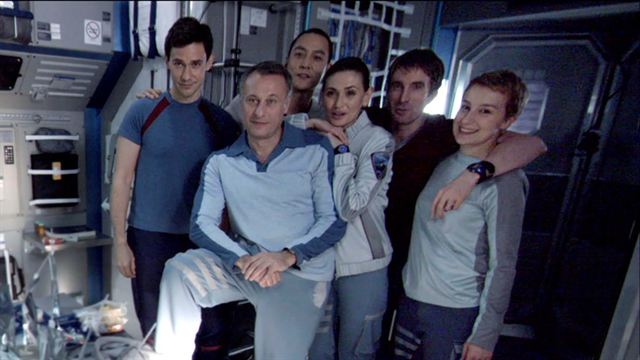 The crew before….there were none.
The crew before….there were none.
Repairs have to be made and are routine,… not all. One repair requires an EVA and when a bolt flies out, the first crewman is lost, drifting off into the void in radio contact for a while…. No bang, just a whimper.
They land on Europa, as per plan, leaving the orbiter above. It is indeed ice, but not solid. Hmm. Will the ice withstand the weight of the lander? It seems OK. They do some ice fishing, cutting a hole and dropping a probe down into…. yes, it is water. The data streams in, then the probe stops. Huh? What happened? An IOS update? Flat battery? One of the crew goes to change the battery and sees the ice cracking and… Two down.
Another one forgot to fasten the seat belt. Whack. Three down.
So it goes until only one is left.
These are explorers like those who went with Columbus, Lewis and Clark, Captain Cook, Marco Polo, Edmund Hilary, Robert Scott, Thor Heyerdahl, and their ilk. They want to know what is there, and send that knowledge back to Earth. Or the scientists like Marie Curie who exposed or injected themselves to their discoveries to see what happens.This desire to know kills each of them one-by-one like the Agatha Christie story shorn of the evil mastermind making it happen. Just the laws of physics.

The film is distinctive in good part for what is not there.
1.There are no meteors to provide an easy crisis. This is the oldest chestnut in the Sy Fy writer’s manual.
2.There is nothing military about the exercise, and no weapons of any kind were on show. No wonder the NRA banned it.
3.There are no political echoes from Earth of any kind. No scheming Russians, no holy Greenies, no nothing of that sort. In no sense is this mission to save Earth, another common trope omitted.
4.There are two women in the crew of six, and there is nary a word about whether a woman could be a scientist and a woman, etc. All that tiresome, trite, and trivial nonsense so favoured by scriptwriters of Sy Fy in the 1940s, 1950s, 1960s, and 1970s. Oddly, they got paid for writing such bilge. One hopes they are out of work today.
5.Although the mission is a private business there is none of the corporate chicanery beloved by the scripts in the Alien sequence. The CEO suppresses emotion at times recounting the fates of the minions.
6.There are daring deeds but no grandstanding heroics to pull off a miracle. It is realistic enough that most of the time crew members are wrapped in safety gear, which they do not rip off for close-ups pace ‘Arrival’ (2016). None have make-up like Sandra Bullock in ‘Gravity’ (2013).
7.There is no creature in this feature. Much to the annoyance of the monkeys at keyboards who have commented on IMDb and You Tube. Yes, they do find an amoebae of sorts in the water and that is life, and that is tremendously exciting, but that bug does not cause any trouble. It just is.
8.There is, mercifully, no comic relief. No character who tells jokes trying to be funny, emphasis on trying. This figure appears far too often and in many films the butt of the humour is woman. Glad to be rid of that.
9.And there is no salvation. They all die. Very lifelike.
‘Trans-Atlantic Tunnel’ (1935)
‘Completing the Channel Tunnel in 1940….’ are the opening words of this futuristic movie made in the depths of the Great Depression from the typewriter of the then recent German refuge Kurt Siodmak while in England.
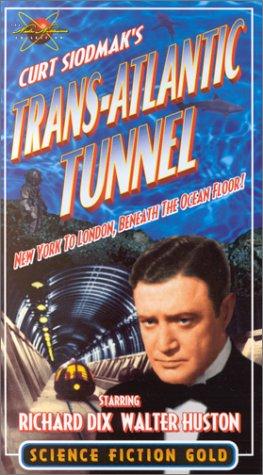
Face-time video telephone calls are common. Giant television screens in public squares, on outside walls, in railway stations are the source for news. Aerodynamic designed automobiles glide by. Non-stop transatlantic flights ply the airway from London to New York City and back. (The first non-stop flight on that route occurred in 1958). The face-time calls are also made from the airplane to home. The first passenger train took the Chunnel in 1994. As always Curt was ahead of the times.
The 1940 Channel Tunnel led to the development of a steel that can hold up the universe and a radium drill that churns through all matter and antimatter, too. The investors who paid for the development of those technologies want to see them used again for a return on that investment. The financiers gather to start the trans-Atlantic tunnel. Among them are many wheels within wheels. Some are motivated by philanthropy, others see in the Tunnel greater unity to prevent (another) war (though the Great War is never mentioned explicitly or implicitly). some are there for the likely profit, and then there are the merchants of death who think the tunnel (somehow, and this is never explained) will lead to war and increase demand for the armaments they have to sell.
There are three plot lines, which is three more than in some films reviewed on this blog. First is the Tunnel itself. Second is the personal life and relations of the Chief Engineer on the project. Third are the machinations of the financiers. Without a doubt the Tunnel is the star of the show.
The Tunnel is a gigantic maw that consumes money, labour, tools, lives, men, emotions, patience without end.
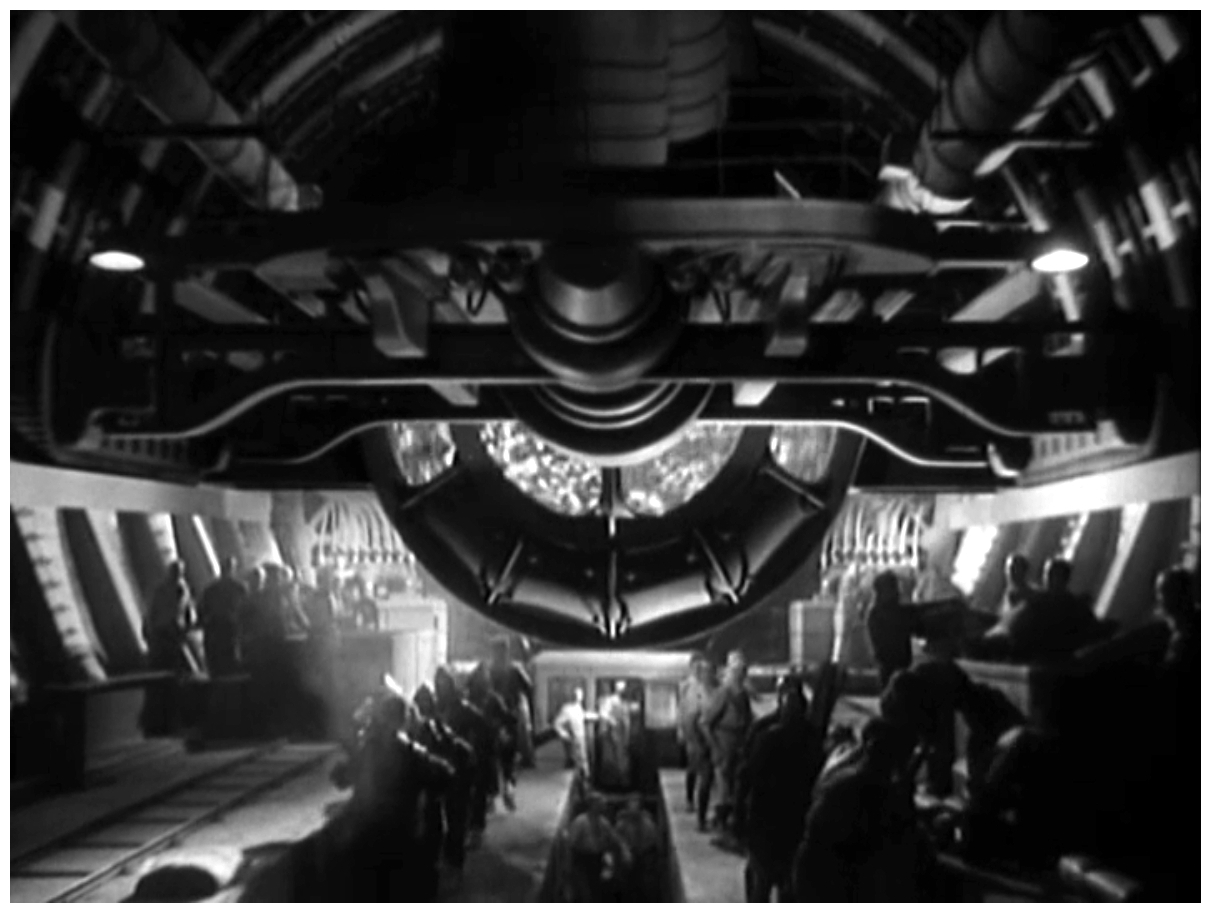
The five year project takes twenty. (Mega-engineering forecasts have not improved since then.) Chief is so obsessed by it that he does not notice his son or his wife. Wife tries to share his passion for the Tunnel by going to work as a nurse in it, where she contracts Tunnel disease from the gases and goes blind. Chief does not notice. Now blind (but evidently wealthy) she leaves him with the son. Chief does not notice. The son grows up. The Chief does not notice.
The daughter of one of the philanthropic investors is madly in love with Chief, married or not. Chief does not notice. She throws herself at him repeatedly. Chief does not notice. (This man needs glasses. Look at those assets.)
The financiers buy and sell Tunnel stock to drive others out of the project and Daughter sells her body to the arch villain to secure continued funding for the Tunnel. Chief does not notice.
Accidents, floods, power surges, equipment failure bedevils the project. These the Chief notices. He throw himself even deeper into the work. Workers die. The Chief does not notice. HIs son comes to work in the Tunnel. The Chief does not notice. His son dies in the Tunnel. At last the Chief does notice this, and united by grief he and Wife reconcile.
The Tunnel is vast, on two vertical levels with two way monorail traffic and a two lane road between the monorails.

Nothing like the dual tubes that comprise the Chunnel, which is still losing money. Its investors are still in the red.
Daughter discovers that life with the villain is exciting.
The British Prime Minister and the US President pontificate on the unity of the English-speaking people, though Canada, New Zealand, South Africa, New Zealand, Nigeria, the Bahamas, and Australia are absent from this incantation. Walter Huston does the US President whose pathetic pension meant he had to go to Mexico to find ‘The Treasure of the Sierra Madre’ (1948).
In the end, Chief has to do it himself. He does. End.
It got a laudatory review in the ‘New York Times’ and so it should. The design and staging are striking even today. Siodmak’s futuristic toys outdo ‘Metropolis’ (1926) and its successors like ‘High Treason’ (1929), ‘Just Imagine’ (1930), or ‘Non-Stop New York’ (1937).
The Chief was completely consumed by the Tunnel. How will he live now that it is completed?
It was made at a time when talkies were filmed in three (or more languages) in parallel. The props, costumes, designs sets, and story on the English version were used with a different actors and directors in French, and then again with another cast and crew in German. All this was done quick smart. Doing this led to huge multi-lingual and multi-national production facilities like Gaumont in Paris and UFA in Berlin.
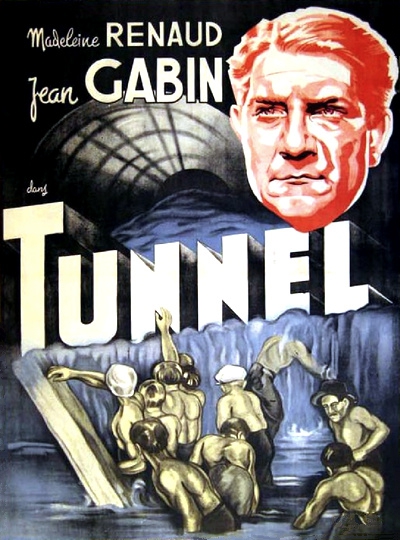 The French version.
The French version.
These polyglot facilities later opened doors for actors, writers, directors, designers, engineers, cinematographers, and others to move from one country to another after 1933.
From the IMDB, 1 hour 34 minutes at 6.2/10 from 548
‘Invaders from Mars’ (1953 and 1986)
‘They won’t believe me,’ should be the tag line for this story. It has been rendered twice. In 1953 it ran one hour and seventeen minutes scoring 6.6 from 5828 votes, while the big budget CGI version in 1986 is 5.5 from 5972 votes running one hour and forty minutes.
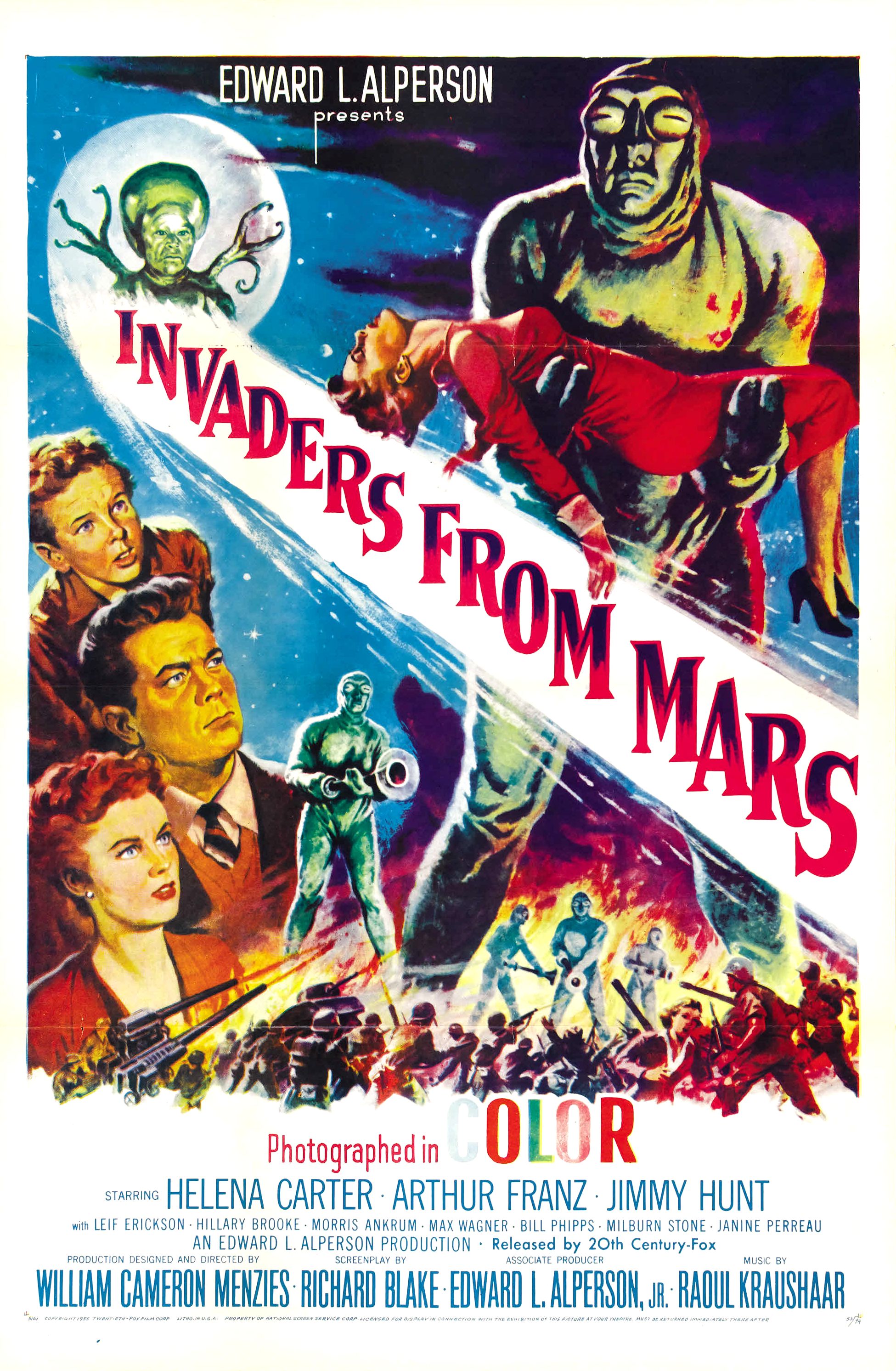 The 1953 lobby card makes it into a creature feature.
The 1953 lobby card makes it into a creature feature.
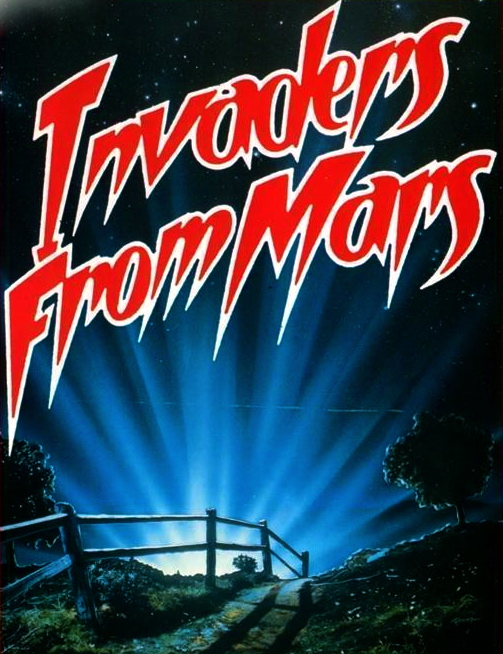 The 1986 cover.
The 1986 cover.
A boy of twelve is a star gazer, and he sees a bright light land just over the tree line. He convinces his dad to check it out. The re-make mimics the original in this scene and yet it is played differently. In the original there is mystery, while in the second it is explicit. In the original the loving father comes back from checking out the light a zombie in some kind of inner pain. While in the second he comes back an automaton with no interior. Leif Erickson in the original plays this transformation very well. He is no longer the loving father, but in distancing himself from his son, on his face we seen confusion and even anguish, while in the latter version the dad comes back an expressionless robot.

The subtlety of the original is lost in 1986. While in 1953 the persistence of the boy triggers events, in 1986 he is a midget Indiana Jones who makes things happen. Indeed at one point the Marine general defers to him. Ah huh.
Mind, there are some nice touches in the 1986 take, as when Nurse Ratched is caught eating a live frog, legs last. If only Red could have seen that. I also liked the unspoken reaction to the mother, now a zombie, burning a pile of bacon to blackened ruins and then calmly eating it. A frog, well that is odd but what do you expect from Ratched, but charred bacon is positively appalling. She must be an alien to do that. Burn it, I mean.
The only character in the 1986 version who bites into his role is the general who hams it up for all its worth. He, at least, knows it is a joke. While I loved the general, the time it takes him to blast the Martians was boring.This part was played in 1953 by that Sy Fy stalwart Morris Ankrum, of whom no criticism will be heard.
In 1986 Karen Black gives a a good performance but it does not match the material, but this woman can look worried, thoughtful, determined, and more. She is trying but …. its not enough. Yes, I know the boy is her son and perhaps that explains a lot. He seems to be stubborn, wilful, and blank most of the time.
There is far too much CGI of the Martians and their tunnel. It goes on and on and bored me. The rubber suit for the Martian in 1953 is preferable to this monotonous red CGI. The planet is red, see, so the Martian bugs are red, too, and everything around them is red, see. Yes, I saw.
In addition, I was never quite sure what the Martians were up to. Ugly yes, but what else? Yes, yes, I saw the NASA connection but I still did not fathom the point there, and since it is all boom-boom there is never an exposition, not at least while I was still engaged enough to notice. In 1953 it was clear they wanted to thwart the spaceflight but in 1986 there seems to be more to it, and less.
I liked the tribute of 1986 to 1953 in casting Jim Hunt, who was the boy in the earlier film, as the sheriff in the re-make. A nice touch.
OK, I admit I did some FF and may have missed the subtlety. While confessing, my comments on the 1953 version come from the Mind Palace, not a recent viewing.
‘Operation Ganymed’ (1977) and ‘Orion’s Loop’ (1981)
Operation Ganymed 1 hour 56 m 6.6/10 from 258 : Orion’s Loop 1 hour 25 m 5.6/10 from 78
These two Sy Fy movies have much in common with each other and with ‘Space Odyssey’ (1968) and ‘Solaris’ (1972). As to the latter they are post-modern avant le mot, ambiguous, incomplete, contradictory, unreliable, deceptive, all much like some …[fill in the blank] I have known.
‘Operation Ganymed’ from West Germany starts with astronauts returning after several years from a mission to Ganymede, a moon of Jupiter, which went wrong, leaving members of the expedition dead. (We never find out why Ganymed?) The five left are returning to Earth, among them Jürgen Prochnow, in a hurry to get to Das Boot. These survivors are dazed, battered, and anxious as they power home. The anxiety turns to angst as they near the blue dot because there is no radio communication. They keep calling but no one picks up, and yet they are sure their radio is working. If they cannot get ground help, it will be hard landing. Siri! Wake up!
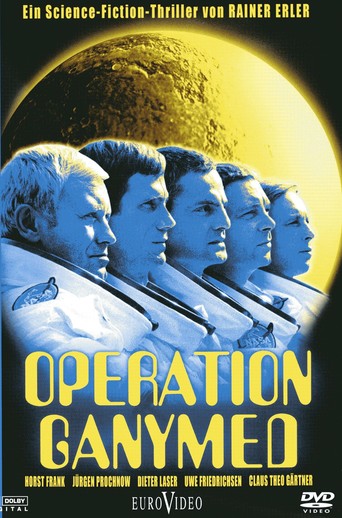
As for the Russkies, there are many space ships out and about and recently a number of them have come to grief. No, not by coming across Rush Limbaugh broadcasts, nothing that awful. Rather some unknown kind of radiation is penetrating the ships and driving the crews mad, and killing many of them. Video evidence from an Italian space ship shows the crew, eschewing pasta, and bashing into walls in their orange jumpsuits, double knit with flared trousers. Hold on, any Italian made to wear such a clown-suit would surely contemplate suicide.
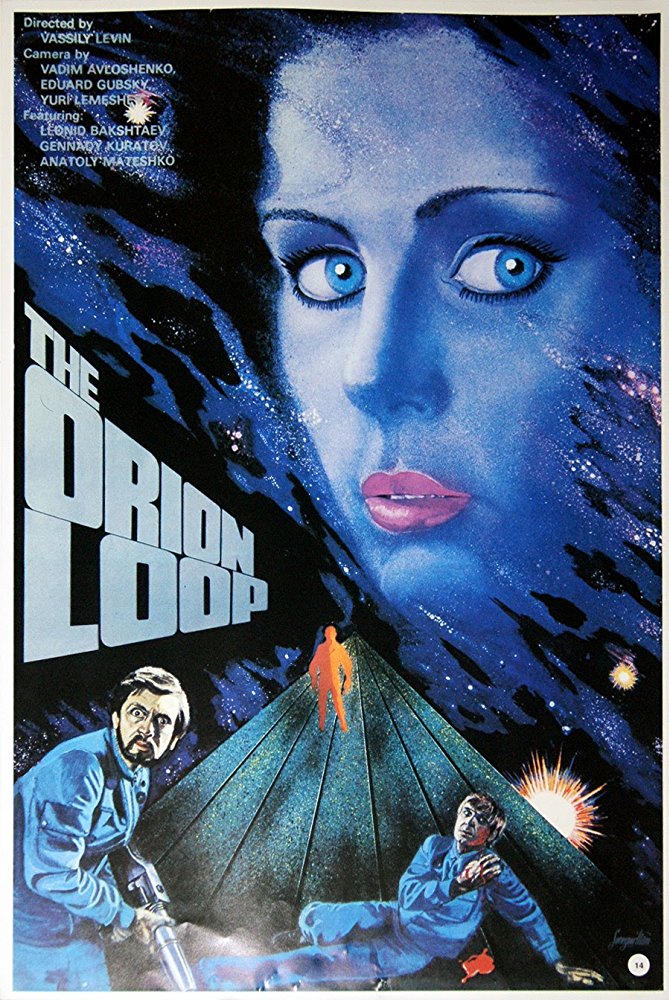
A committee meets. [Shudder.] Pontificating follows. Ditto. Ditto. The Libras want to study the phenomenon for a while, maybe forever. They can see research grants galore, fulfilling their KPIs, until retirement. The Taureans want to get out and taste the radiation. The noble Russkies agree to lead the mission in purpose-built ship they have whipped up. There were eight or nine of them. Each is cloned into an android to ease the burden. This gimmick is not integral to the plot and used in only two scenes. Much ado about little. The androids do not seem to be proof against the brain pain radiation later.
Distracted by the hijinks of the fraternity brothers, this correspondent missed some details, now and later, in both films. Ahem.
The Germans have no help and have to land hard and out of control. Surviving the landing, they emerge from their craft rocky and rolling after years in low gravity space. After some this-and-that, they guess that they missed the Pacific Ocean! Instead they are in Baja California near that ocean.
That is the mystery. What happened? Where is everyone? Meanwhile, how are these weakened men with only a few leftover supplies from a four-year mission survive in the harsh desert conditions in which they now find themselves? This environment is as harsh and forbidding as any Martian landscape shown in other Sy Fy films.
While the imperatives of the operation on Ganymede and then the concentration required to return kept the five cohesive and sane, this empty desert weakens those bonds. Injuries, delirium, dehydration further impair them. They head north and come across a few abandoned trucks and a few empty villages at crossroads. But no people, dead or alive, nor any animal or bird life. Just that rugged, endless, dry stony desert under a relentless sun.
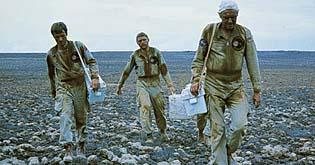 The walk.
The walk.
We then get the dreams and nightmares of the individuals. I loved one who dreamed of being the only survivor interviewed by the media while himself dying. The carrion of the media attack him with a battery of trivial and stupid questions, oblivious to his mortal distress as he dies under the barrage of their self-serving and aggressive questions. It seemed so plausible and realistic it could have been on the ABC.
Another stunned astronaut, blinded by the sun, imagines himself in a ticker tape parade of welcome.
A third has disconnected, blurred flashes of what happened to the others on Ganymede.
This parade of delusion interspersed with conflict among the five, though they are too exhausted for much.
On the other fork in the space-way, the Russkies are nearing the energy source which is cotton candy whirling in space. Their craft has all manner of special shielding, such as applied to those about the go to a dean’s budget briefing, but even so members of the crew start experiencing brain pains of considerable magnitude, though not as bad as though endured by budget meetings. It kills some. Even the androids need Tylenol. Others put on headphones to listen to Reiki music to recover. (Well, that is what it looked like, and I missed some the subtitles.) The crazier ones want to destroy the ship by pulling the USB cables out without ejecting the device in the prescribed manner! Unsafe withdrawal! That is a death wish! Others just want to go home. More die, though there is no gorefest. They just creep off and lie still. Kind of like Alexander Technique exercises.
 Barnard’s Loop stands in for Orion’s.
Barnard’s Loop stands in for Orion’s.
Whoa! Other members of the crew get holographic visitations that seem to be communicating with them. It takes a while to tune into the channel, but when they do, the message is, ‘Wait! I am not a dream. Listen.’
These visitations cause pain to the one visited, like when the in-laws come for Thanksgiving. The holographs have been trying to tune their visits so as not to kill those visited, something in-laws never do. The holographic visitors do some Geordie Speak and claim that they are there to help. Ah huh, this is after killing the crews of several other ships with these brain-pain inducing visitations. The energy field called Orion’s Loop, which the holographs have created, will save Earth from a speeding orb on a collision course, not yet sensed by Earth’s primitive instruments. Ah huh. But Earthlings must not interfere with the Loop. (Why did I just think of El Trains in Chi Town?)
‘We come in peace. We are here to help.’ That is what the holographs say as they flicker in and out. The visits seem to take a lot out of them, too. Why they did not try FaceBook is unknown where all the other weirdos go. The Russkies have heard all that before. Said it even. Some think it is a trick and without ejecting pull out more USB peripherals, while others dally with these spectral visitors. Dally. Pull. Dally. Pull.
Then it ends.
Back to the Germans. A couple of the wandering astronauts die in the desert.
Then it ends.
‘Operation Ganymed’ is a character study as each of the survivors deteriorates. While ‘Orion’s Loop’ shows the reactions of crew members to these alien apparitions.
Both movies have effective set designs, especially the Russkie computer, which is walk-in, like the one that used to be in the computer museum in Boston. The spaceships, the space suits, the instruments, especially in the German take, all have a verisimilitude to this viewer. Though the Germans are always complaining about what junk their Audi ship is. Whinge. Whinge. Whinge. It got them there and back.
Both movies are like ‘Odyssey’ and ‘Solaris’ in being cryptic, and it is left to the viewer to get something out of them. OK. Not something I would pay to watch, but far preferable to the Italian Sy Fy I have seen where there is a story and plot and both are confused and nonsensical, and evidently forgotten by the cast half-way through. No loss.
